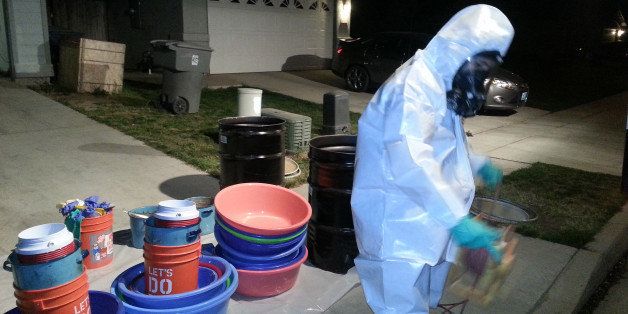
While Breaking Bad has given us a multiyear tutorial on methamphetamine in America, many questions remain for policymakers and social scientists. Is meth use a growing problem and an emerging epidemic? Is it mostly a rural drug or a West Coast phenomenon? How is it that some places in the United States seem to have little to no meth use while others are inundated? Are meth markets different from those of other illicit substances, and if so, how?
Our four-year study of methamphetamine markets taught us that most of the questions about meth can be answered by understanding the dynamics of the relationship between meth markets and public policy. We found a complex, multifaceted, transnational industry. At one extreme, meth is produced in small batches for local use and sold to just a few people who know one another. At the other, we found a large, sophisticated business operated by international cartels that depend on locally known and trusted users, much like franchises, to sell their product to local customers.
Our research was sponsored by the National Institute on Drug Abuse, and our findings are reported in our recently released book, The Methamphetamine Industry in America: Transnational Cartels and Local Entrepreneurs, published by Rutgers University Press.
We studied meth markets from the perspectives of the people who participate in them and the people whose lives are directly affected by them. We surveyed police agencies in every state, conducted in-depth interviews with narcotics detectives, informants, meth users and dealers, drug treatment and prevention workers, family service providers, and others whose lives intersect with the methamphetamine industry in more than 28 cities and towns across the United States.
Alone or with a guide, we walked or drove through areas known to house meth users and dealers or to be places where meth transactions occurred. We attended community events where local citizens talked about personal and community issues and problems related to local meth use and markets. We toured the U.S.-Mexico border, guided by a member of the U.S. Border Patrol.
Everywhere we traveled, no matter what type of market organization or operation dominated the area or how good or bad the quality of the product sold, we found that relationships and transactions in methamphetamine markets are always personal. Wherever we went and whenever we asked where we would go to purchase meth in the area, the answer was always the same: "You can't. You have to know someone."
In an industry built on personal relationships, the picture of methamphetamine markets in the United States is one that is shaped, ironically, by the same regulations that were put in place to control them.
We found that restrictions in the United States on the ingredients needed to manufacture meth resulted in a windfall for international cartels that seized this market opportunity, flooding the United States with high-purity crystal methamphetamine, and displacing small mom-and-pop meth operations in areas not previously penetrated by international traffickers. Nevertheless, we also found that local mom-and-pop operations are still thriving and even dominating in some areas, especially across the Midwest, where international operators have had less success opening new markets.
Regardless of which type of market dominates in any particular area, people all across the country, particularly users and dealers and social service and family service providers, made clear to us that methamphetamine "is a family drug," and challenged us that -- if we wanted to understand meth markets -- we also needed to understand the relationship of the markets to families and particularly children.
In the smaller operations, meth is frequently cooked with children present and exposed to the toxic chemicals and fumes and to domestic violence. We spoke to parents and grandparents who had introduced their children to the drug in what amounted to a bizarre form of family bonding. We spoke to parents and grandparents who told us they had introduced their children and grandchildren to methamphetamine so they would feel closer to them. We met a mother whose daughter took over the family meth dealing business at age 14 when the mother became too sick from using to continue. We listened as family service providers told us that they were "treating second and third generations" of the same family, children and even grandchildren. One woman we met told us how her dealer exploited her addiction to meth to encourage her to introduce her children to him so that he might start selling to them.
We were further surprised to hear stories told by former meth users across the country -- eerily similar, paranoid accounts of hiding in their trailers, peering out of slightly opened window blinds, fearing that they were being tracked by sensors used by police, paramilitary, or other extraterrestrial forces. Surveillance cameras, they were sure, were everywhere, inside and outside of their trailers. Worried that their TV sets, DVD players, and other electronic gadgets were wired and watching them, they tore them apart, piece by piece, then added them to the growing pile of other electrical equipment heaped on their front or side porch. Outside, they heard and hallucinated about seeing black helicopters circling above, paratroopers landing in their yards in camouflage army fatigues. They told of snipers, wearing orange ski masks, perched in trees surrounding them. Coast to coast we heard similarly vivid stories of users staying up so long on the drug that they reported staring the Grim Reaper straight in the eye.
Breaking Bad may have gotten a lot of the story right, from the family nature of the drug to the penetration of the industry by Mexican cartels. Our research reveals new information about the personal nature of meth markets, the unintended consequences of legislation put in place to curb its manufacture and use, and the drug's terrible impact on children. Now the challenge is to move from understanding the phenomenon to addressing the problem with informed policy and practice.